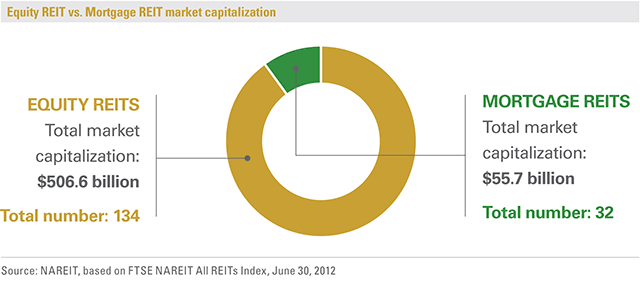Types of REITs How REITs Work
Post on: 10 Июнь, 2015 No Comment

Types of REITs
REITs are part of an extremely diverse industry. Not only are there different categories of REITs, many different property types and classifications can comprise them.
Let’s start with the three REIT categories: equity. mortgage and hybrid .
Equity REITs (EREITs) purchase, own and manage income-producing real estate properties such as apartments, malls and office buildings. Equity REITs are different from typical real estate developers because they purchase or develop real estate to operate it as part of their portfolios instead of developing it for resale. Equity REITs are considered superior for the long-term investing because they earn dividends from rental income as well as capital gains from the sale of properties.
Rather than investing in properties, Mortgage REITs (MREITs) loan money for mortgages to real estate owners or purchase existing mortgages or mortgage-backed securities. Their revenue is generated primarily by the interest that they earn on the mortgage loans. Mortgage REITs react more quickly to changes in interest rates than equity REITs because their dividends come from interest payments. Today, there are close to 40 mortgage REITs. Of these, about 25 invest in residential-mortgage securities and the rest invest in commercial mortgages. Mortgage REITs are considered a good speculative investment if interest rates are expected to drop.
As their name suggests, Hybrid REITs are a combination of equity and mortgage REITs. They both own property and make loans to real estate owners and operators. Hybrid REITs earn money through a combination of rents and interest.
Some REITs are established for a single development project and set up for a specific number of years. At the end of that time period, the REIT is liquidated and the proceeds are distributed to the shareholders.
There are also classifications based on whether or not the REIT can issue additional shares. If the REIT is a Closed-end. it can only issue shares to the public once and can only issue additional shares, which dilutes the stock, if current shareholders approve it. Open-ended REITs can issue new shares and redeem shares at any time.
Although some REITs have a broad focus and invest in a variety of property types in a range of locations, many REITs focus their investments either geographically or by property types. An individual REIT may hold properties only in a specific region, state, or metropolitan area. Or, it may hold properties across broader geographical areas but focus on healthcare facilities, apartments or industrial facilities.
The National Association of Real Estate Investment Trusts (NAREIT) divides REITs into three classifications based on how they can be purchased: private. publicly traded and non-exchange traded .
Private REITs are not registered or traded with the Securities and Exchange Commission (SEC) and raise equity from individuals, trusts, or other entities that are accredited under federal securities laws. Private REITs generally are subject to less regulation, with the exception of guidelines associated with maintaining REIT status. There are almost 800 private REITs in the United States.
There are nearly 200 publicly traded REITs registered with the SEC and traded in major stock exchanges such as the New York Stock Exchange, NASDAQ and the American Stock Exchange. Because they’re traded on an exchange each day, publicly traded REITs are simple for investors to buy or sell and offer great liquidity. Total assets of these listed REITs exceed $400 billion.
About 20 non-exchange traded REITs are registered with the SEC but not traded on any of the public exchanges. Instead, they have private sponsors who market them to investors-often those who have been burned elsewhere in the market and seek relative stability. In exchange for easy liquidity, REIT sponsors focus on the benefit of not having to time the market. They often promote non-exchange traded companies as providing insulation from fluctuations in the market and, in part, as fixed-income investments that offer better returns than bonds. certificates of deposit. money market funds and similar financial instruments.
Next, we’ll look at how REITs operate.
Taxable REIT Subsidies
REITs are restricted in the types of services they can provide to tenants. Additional tenant services, such as housekeeping services, must be offered through a Taxable REIT Subsidiary (TRS). A TRS is a separate corporation in which a REIT has an interest. TRSs pay corporate tax at regular rates on their taxable income. Dividends the REIT receives from the TRS fall under the 95-percent income test. Other additional TRS rules include limits on the amount of interest and rents that the TRS can pay to the parent REIT.














